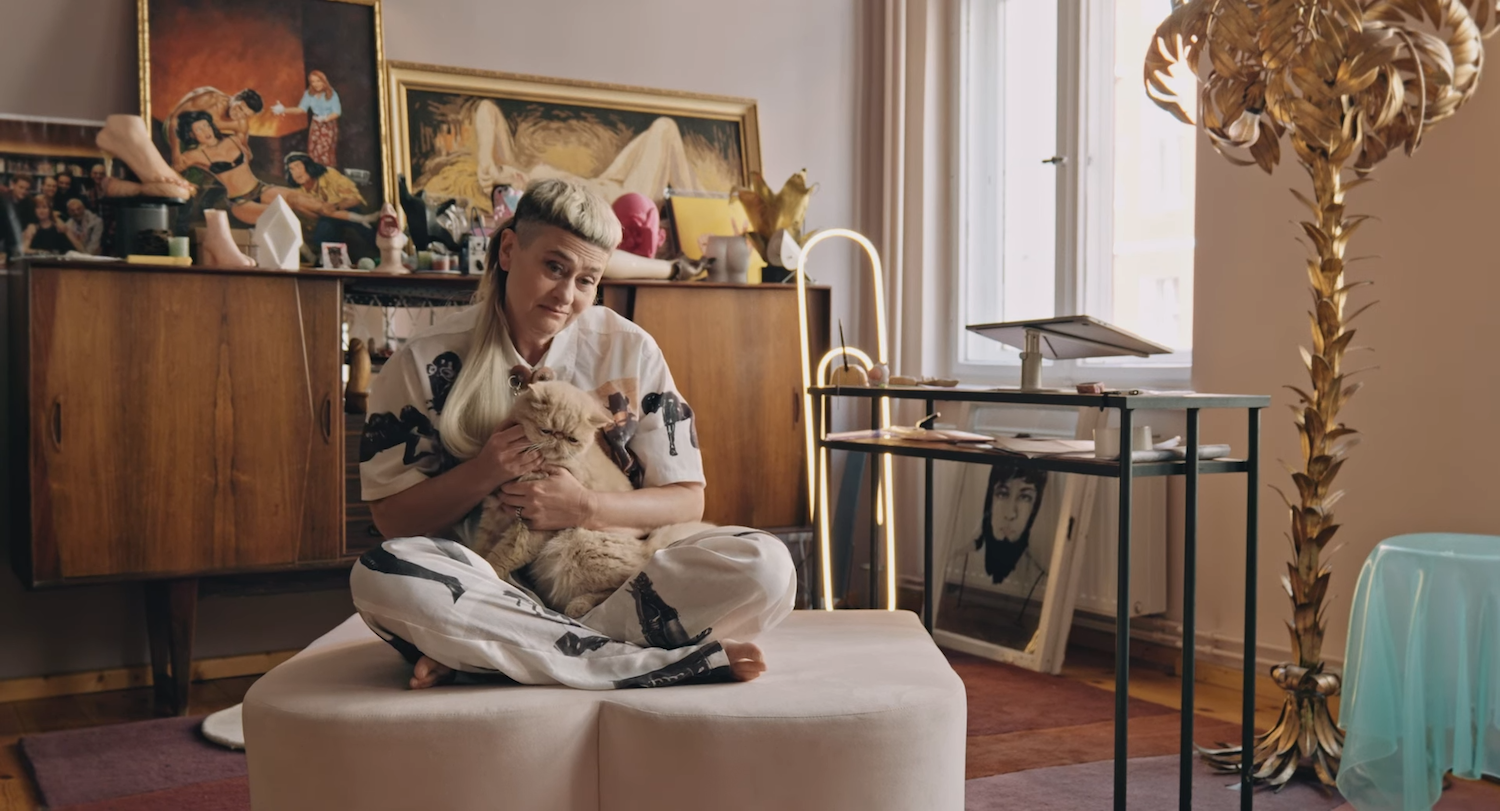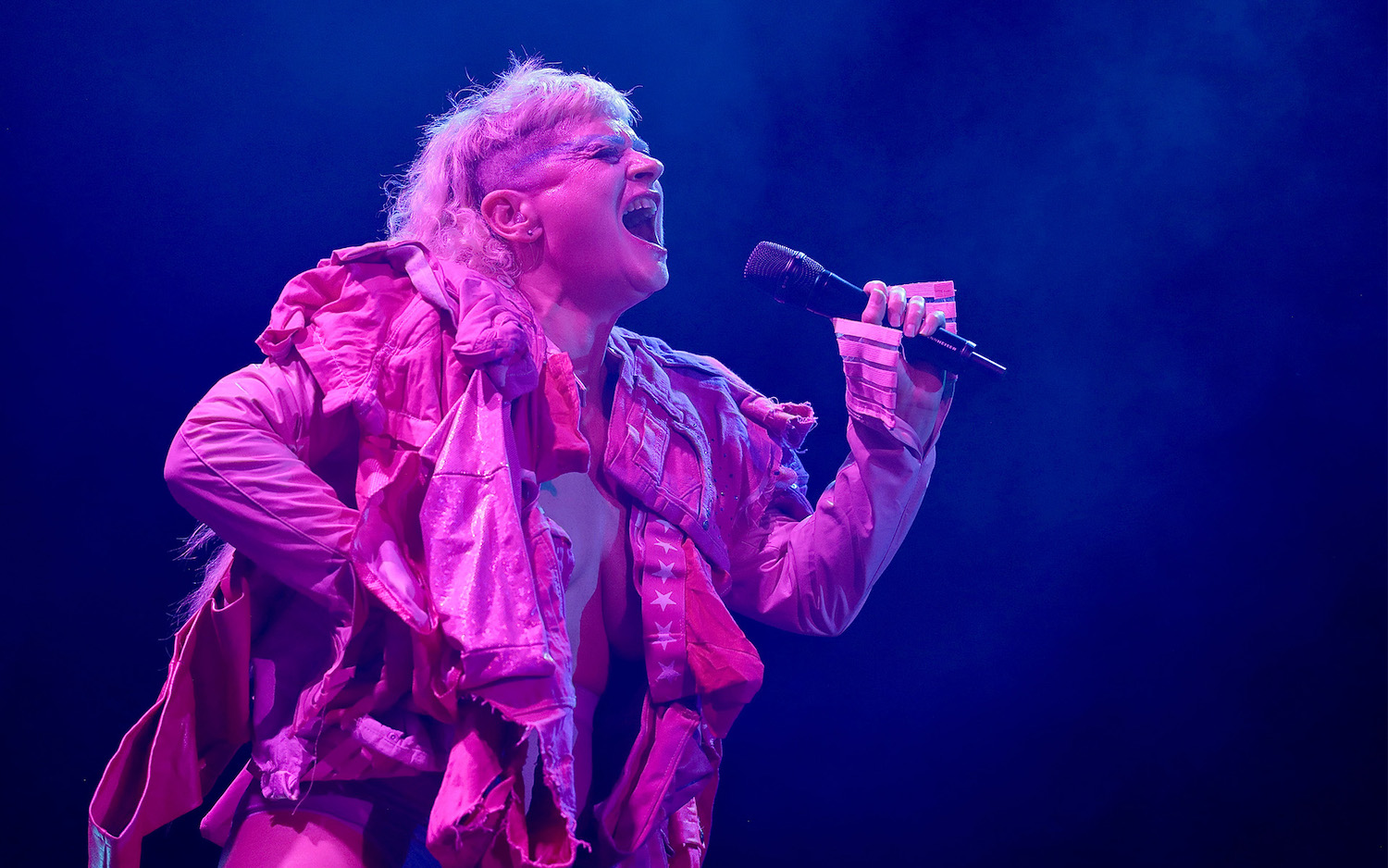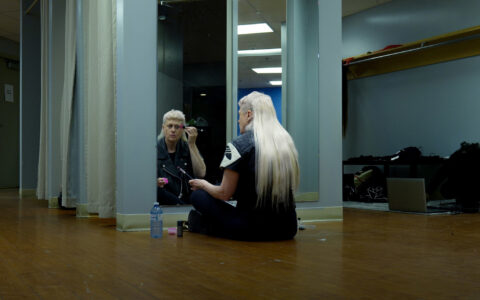From YMCA music teacher to global icon, Philipp Fussenegger and Judy Landkammer’s documentary The Teaches of Peaches (2024) chronicles the extraordinary journey of Merrill Nisker, aka Peaches. Filmed during her 2022 anniversary tour, the film delves into her rise to the top of the Y2K electroclash scene and her transformation into a revered queer feminist voice in music.
A punky and spirited blend of never-before-seen archival footage, electrifying concert visuals and chats with collaborators like Chilly Gonzales, Shirley Manson and Peaches herself, the documentary offers a comprehensive look into the artistic process of this groundbreaking Canadian artist. Additionally, it provides a glimpse into the dynamic world of touring, immersing both longtime fans and newcomers in her unique life. We caught up with Fussenegger, Landkammer and dramaturge Susanne Heuer for a chat about their new Teddy-Award-winning film for Best Documentary.
Peaches comes off as very affable and comfortable in front of your camera. Tell me about your process in establishing director/subject trust. How did you all meet and decide to make the film?
Well, our producer Cordula Kablitz-Post had the initial idea to make a Peaches documentary based on the upcoming 25th anniversary of The Teaches of Peaches album.
Philipp and Susanne Heuer had already been working on a documentary about the KitKat club in Berlin with Cordula and then got introduced to Peaches. It was clear that the energy between them and Peaches fit immediately.
Cordula also felt that our team and approach were the perfect fit for a project like Peaches. Judy Landkammer and Philipp have been working together for more than a decade, they understand each other very well and have a good work dynamic. Our dramaturge Susanne, who was also already on board for the KitKat film, joined the team. The three of us spent many hours in the editing room together moving around tons of colourful Post-its and index cards on a 3x3m wall.
We approached Peaches as a team and we met and talked about who we are and how we work together. We established clear boundaries for filming on the tour, safe spaces, feedback loops, etc. That created space for an ongoing conversation and growing trust.
The movie was written in the editing room constantly evolving through conversations with people past and present. It grew like a tree alongside the trust that was built bit by bit. This led to the final interviews with Black Cracker and the cats.
How is the work split up between you two as co-directors? Who does what?
The way we work might be rather unconventional as we don’t have such clear lines between the different roles. So on a practical level, you can imagine it as follows: Philipp, who was at first the only director, went on tour with our DOP Dino Osmanović, not only taking over the role of director but also sound technician. It’s not an easy task to do both at the same time!
When Philipp came back from the tour, he was pretty exhausted but started going through the first bits of archive material together with Susanne, making our beloved Excel lists with keywords and colour codes and all that. Judy joined in a bit later as the editor and went through all the anniversary tour footage (10 shows + rehearsals + a lot that happens around that).
For the first four weeks, Judy was entirely alone in the editing room. She first had to get familiar with the material herself. Philipp was also not quite sure how to approach the narrative and structure, and how to weave everything together. One late evening Judy sent over a two-minute clip and Philipp called five minutes later very euphorically and said: “Now I am certain it will become a film, we can do this!”
It was neither supposed to become a classical tour film nor a biographical film. There are such important themes that run through Peaches’ life and work like a red thread. We wanted more. Together with Susanne, we created the narrative and structure of the film, deciding together step by step who we could interview and which questions we wanted to ask. Some tasks got split up, so, for example, Susanne wrote the interview questions, Philipp was responsible for doing the actual interviews, and Judy did the editing throughout. This resulted in many in-between versions of the film, constantly growing and evolving with the people we met.

It seems that Peaches has a vast archive and saves everything. How long did it take you to go through all these old videos, photographs and mementoes while prepping?
We were faced with a vast and pretty overwhelming amount of footage that was not only made up of the anniversary tour but also countless terabytes of private archival footage that Peaches allowed us to look through. We are speaking about 20 years of footage that she and her friends filmed, collection of TV interviews, music videos, etc. A lot of it was already digitised but we also had boxes and boxes of original Mini DV tapes.
To go and think through that all, you definitely need a couple of pairs of eyes and ears. Luckily we had at least 3 pairs (Philipp, Judy, Susanne). It took us weeks to get only a rough overview of what was there and then find a way to organise it. This led to creating lists over lists because your memory wouldn’t be able to keep up with everything.
The entire process was also slowed down by the fact that tapes needed to be digitised and we needed to find a functioning player first. Philipp was the “lucky one” to do so, with many ups and downs as a lot of recorders just wouldn’t work for certain tapes or break. That was an ongoing side-task during the entire editing process; sometimes we really found hidden treasures.
From there, the film developed like a conversation with old footage, which then fed into the interview questions for Shirley, Feist and Chili. It was constant editing, writing and rewriting.
Is it intimidating to try to sum up a life and career like Peaches’ in 100 minutes?
Intimidating, yes, but it was never really the goal to sum up her life or career. This is not a movie about somebody’s legacy. Peaches is still an active artist. This is a story of becoming. Of crossing the threshold. “The origin story” to the sequel and there are many more episodes to come.
Your film has strong, kinetic, punky interludes, but also some intimate moments. Tell me about the process of making a film that matches the subject’s overall energy. I loved the conversation in the doc about an artist’s onstage presence vs. their private life.
Well, there certainly were, like in every artistic process, moments of great excitement and also bits of desperation. Some things flow, others turn into a tedious process.
The excitement of getting all the tapes was followed by the overwhelming task of looking through them.
Some wonderful moments in the interviews like Black Cracker’s memorable quote about genitalia, “If you’re not sucking on it, it’s none of your business,” came out of a long conversation and our struggle to address difficult topics in the film. Peaches was going on tour in the US and there was tension in the air with the abortion bans, transphobia and queerphobia. At the same time, we didn’t want to make it too heavy.
The film is a punky feel-good movie with serious undertones. Just like Peaches is an upbeat stage persona that talks about dark feelings and addresses pain in a celebratory fashion. And of course, not every day is “jumping around in a pussy costume” day.

What did you try to avoid while making this film? Any aesthetics or clichés you strictly stayed away from?
We wanted this movie to be a queer feel-good movie, where people leave the cinema positively energised, no matter if you are a hardcore fan or somebody who just stumbled upon this film randomly. We wanted to deliver some messages around certain topics without pushing things on people, which is the way Peaches also delivers certain messages, be it around queerness, ageing or sex-positivity. Our goal was not to dig up or look for any drama in her career or personal life, which we feel a lot of documentaries about musicians and artists tend to do. Drama and tragedy were not on our agenda.
You got to watch a lot of the rehearsals and touring. Was there anything about Peaches’ artistic process that surprised you?
What was surprising was to see how Peaches is really in charge of everything, of every aspect of the show, not in a top-down way, but in a very collaborative fashion.
She would go to storage herself and select old T-shirts together with the merch people to sell at the show. She would sit with the light designer and talk about every aspect of the light. She would be with every single performer, coaching them for the stage performance. But it is all with great family vibes.
She designed her team in a way that people would get on. A lot of the young artists who went on tour with Peaches had never done something like this before. Hilary, for example, worked in a coffee shop before — lots of other young artists were given this space and trust by her.
And it feels that this is what Peaches is really about; giving people space, really looking to see whether everybody’s all right, always asking: “How are you, how are you doing? And you can tell that in the show and the film. Another very interesting aspect of her work is how she was bouncing ideas back and forth with other artists, like how her stage costumes grew. You can see that very strongly in the hair theme. So it started with crotch hair, which then developed into the theme of hair that grew in the “Set It Off” video. And in the end, through people like Charlie, turned into hair sculptures. So there’s a long artistic process in the last decades that developed from maybe just a fun idea.
What was the most powerful moment you had personally making this film?
One of the most thrilling and unexpected moments in the creation of the film was surely when we were allowed to come with Peaches to her storage and she entrusted us with many many boxes of footage on hard drives and tapes in the most casual way.
We were mega happy about it when we carried all these boxes home. Then a very long and tiresome process began… Digitising, viewing, sorting, analysing….
What are you working on next?
All three of us, Philipp, Judy, and Susanne, are back on track with the KitKat documentary, which was the project we were working on when Peaches came in. So that had to go on pause for a bit to be able to fully focus on The Teaches of Peaches. It’s the same team that’s also working on the KitKat project and the same production company. The Teaches of Peaches helped us to grow together as a team.
We found a way to work together collaboratively; having a safe space between the three of us so we can play with ideas. We also developed our artistic style to some extent, so that we now can approach a new topic that also requires great sensitivity. We will be shining a light on different unique individuals brought together in the Berlin club scene.

Editor-at-large Jared loves movies and lives with Kiki in Berlin.
